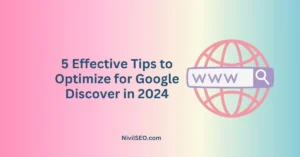How to Make Search Engines Love Your Blog
Have you been asking yourself a question, what could be done to increase traffic to ones website? When used practically, blogging can become an effective way of drawing new traffic, most of which will probably be interested in what you have to present. But how do you ensure those visitors get to your website in the first place? That is where SEO comes to play The following are some of the main areas where SEO is a crucial tool to enhance the performance of an organization’s website.especially with the help of an SEO expert Dubai.
What is Blog SEO?
Think of SEO like a big, flashing sign that tells search engines, “Hey, this website has the answers people are looking for!” Here’s how it works:
- Finding the Right Words: We research what people type into search engines to find information related to your business. We then sprinkle those words, called keywords, throughout your blog posts.
- Building Connections: We encourage other websites to link to your blog posts. It’s like getting a good recommendation from a friend – search engines see this as a sign your content is valuable.
- Making Pictures Shine: We optimize the images on your blog so they load quickly and look great, keeping visitors happy.
Writing Awesome Content: We create informative and engaging blog posts that people actually want to read. This makes them more likely to stick around and learn more about your business.
Why Does Blogging Help Search Engines Notice Your Site?
Algorithms and key factors in sites such as Google are just special systems that determine which site comes out first when people look for something. Blogging helps your website rank higher in these search results for a few reasons:Blogging helps your website rank higher in these search results for a few reasons:
- More Chances to Be Seen: Blogging lets you target a wider variety of search terms than just your main website pages. This increases the chances that people will find your content, especially when they’re looking for specific information.
- Getting Indexed: Search engines can’t rank a page they don’t know about! Regularly adding fresh content to your blog encourages search engines to visit your site more often, making sure your pages are included in their search results.
- Building a Reputation: When other websites link to your blog posts, it shows search engines that your content is trustworthy and helpful. The more high-quality links you have, the higher your website might rank.
- Connecting Your Pages: Blogging allows you to link different parts of your website together. This helps visitors find more relevant content on your site and lets search engines understand how your website is organized.
How to Get Started with Blog SEO
Now that you know the basics, here are some things you can do to make your blog more search engine friendly:
- Know Your Audience: Who are you trying to reach with your blog? Understanding their interests and needs helps you create content that resonates with them.
- Find the Right Keywords: Use keywords that people are actually searching for, but not ones that are too competitive. Longer, more specific keywords (like “best lawn mower for small yards”) are often easier to rank for than broad ones (just “lawn mower”).
- Spice Up Your Posts with Visuals: Use pictures, infographics, and even videos to break up your text and make your blog posts more visually appealing. Don’t forget to add descriptions to your images so search engines know what they’re about.
- Craft Catchy Titles: The title of your blog post is like a headline – it needs to grab people’s attention and make them want to read more. Use strong verbs, numbers, and questions to entice readers.
- Tell People What to Do Next: Every blog post should end with a call to action (CTA). This could be anything from asking people to subscribe to your email list to encouraging them to contact you for a quote.
- Focus on the Reader: Write clear, concise, and informative content that your audience will find valuable. Make sure your posts are well-organized and easy to read. You might even want to consider getting someone to proofread your work before you publish it.
- Keep it Simple: Shorter paragraphs, clear headings, and bulleted lists can make your blog posts easier to digest. While longer content can be helpful for SEO, quality is more important than quantity. Aim for at least 500 words, but don’t be afraid to write shorter posts if they cover the topic well.
- Get Another Perspective: Don’t be afraid to ask a friend, colleague, or editor to take a look at your blog posts before you publish them. They can offer fresh ideas and help you catch any errors.
- Use What You Already Have: Don’t reinvent the wheel! Link to older blog posts in your new ones to keep visitors engaged and show search engines the depth of your content. You can also update older posts with new information to keep them fresh.
Factors Affecting Blog SEO
1.Dwell Time
Imagine someone walks into your store, browses for a while, and then leaves. In the SEO world, that “browsing time” is called dwell time. It refers to the amount of time a visitor spends on a page on your blog. Search engines consider dwell time a positive indicator, suggesting your content is engaging and informative.
Here are some tips to increase dwell time:
- Write compelling content: People are more likely to stick around if they find your blog posts interesting and valuable.
- Break up your text: Use images, videos, and infographics to make your content more visually appealing.
- Link to relevant content: Encourage readers to explore other parts of your website by linking to related blog posts.
- Optimize for mobile: Most people access websites from their phones these days. Make sure your blog is mobile-friendly and easy to read on smaller screens.
2. Page Speed
Nobody likes a slow website. If your blog takes forever to load, visitors will likely get impatient and click away. This can negatively effect your search engine marketing ranking.
Here are some ways to improve your blog’s page speed:
- Optimize images: Optimize images: Large photo documents can gradual down your website. Optimize images: Large photo documents can gradual down your website.
- Minimize code: Clunky code can also contribute to slow loading times. Consider having a developer review your website’s code and streamline it if necessary.
- Limit plugins: While plugins can add functionality to your website, they can also slow it down. Only use plugins that are essential and keep them updated.
3. Mobile Responsiveness
First of all, it is necessary to note that the majority of Internet traffic belongs to mobile traffic. Another important factor that can also affect the ranking is the blog’s responsiveness or adaptability to the mobile devices. Fortunately, today most website themes are considered as responsive, which means they will adjust to the size of the screen which is used. Here are a few extra tips:Here are a few extra tips:
- Test your mobile site: Use Google’s Mobile-Friendly Test tool to see how your website looks and functions on mobile devices.
- Monitor performance: Regularly check your website’s mobile performance through Google Analytics.
- Adjust design elements: Make sure buttons, fonts, and other design elements are easy to see and interact with on a smaller screen.
4. Index Date
Search engines prioritize fresh and relevant information. The date your content is indexed (added to their search database) also plays a role in SEO. Newer content typically gets indexed faster, but older content can be backdated for archiving or minor updates.
Here are some strategies to leverage existing content:
- Update older posts: Refresh outdated blog posts with new information and data. This tells search engines your content is still relevant and can improve its ranking.
- Historical optimization: Develop a strategy to update older blog posts with fresh perspectives. This saves you time compared to creating entirely new content.
5. Recent Data
These characteristics of blogs show that it contains information and statistics that are current and accurate. Credible information from the current sources is a sign to the search engines that the information provided is reliable. This can result in improved values as time on the page, and reduced bounce rates as it refers to visitors who almost instantly leave the site, both of which are helpful for SEO.
Conclusion: Building a Successful SEO Strategy
Thus, SEO for blog is on the regular basis activity. The results of all hard work are rewarding but do not come in one day. Nevertheless, implementing these tips will go hand in hand with the production of quality content that will enhance your blog’s ranking on search engine hence attracting many organic visitors. Here are some additional points to consider:Here are some additional points to consider:
- Set goals: Define what you want to achieve with your blog SEO strategy. Do you want to increase brand awareness, generate leads, or drive sales?
- Be patient: It typically takes several months to see significant results from SEO efforts. Don’t get discouraged if you don’t see a surge in traffic overnight.
- Track your progress: Use analytics tools like Google Search Console to track your website’s traffic and identify areas for improvement.
- Stay updated: SEO algorithms constantly evolve. Stay informed about the latest SEO trends and best practices.
By following these guidelines and putting in the effort, you can transform your blog into a powerful SEO tool, attracting more visitors and boosting your online presence.










